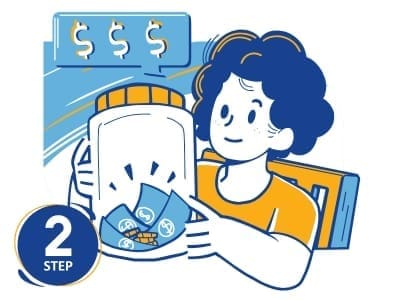
Learn2Earn Rewards!

Age 10: Money Management
Learning to Plan, Prioritize, and Track Money
As kids begin handling their own money, whether from allowances, birthday gifts, or small household chores, this is the perfect time to introduce real-life budgeting skills. BayCoast Bank’s Learn2Earn Rewards program turns those first money decisions into meaningful lessons. Through playful challenges and simple tools, your child will learn how to plan, prioritize, and stay on top of their spending and savings.
What Your Child Will Learn:

Learn About Money Management
Start your financial literacy adventure by exploring the activities and games below. Don’t forget to take your time and enjoy the process.
Click on the Boxes Below to Begin Learning
This article helps kids understand the purpose of a budget and how it can keep them on track with their money. It introduces key terms like income, expenses, and savings in an age-appropriate way and gets them thinking about the tradeoffs they make when they spend.
Tip: : Ask your child what they’ve spent money on recently. Use that as a jumping-off point to talk about what a budget is and how it can help them plan for both fun and important expenses.
This fun printable game teaches budgeting vocabulary and common spending categories through play. It’s a great way to get kids thinking and talking about money in a relaxed setting. As kids listen for words like “income,” “expense,” or “savings,” they start to naturally absorb key concepts.
Tip: Play a few rounds together and pause whenever a new term comes up. Ask your child what they think the word means and give examples from your own life to show how these terms apply in the real world.
This printable worksheet lets your child practice tracking their income and expenses across different categories. It combines everything they’ve learned and helps them visualize how their money moves, while reinforcing budgeting habits and encouraging kids to check in regularly.
Tip: Set aside 10 minutes once a week to sit down with your child and review their worksheet. Talk through any surprises, changes, or decisions they made—and celebrate if they reached a goal!
Using this printable worksheet, your child will create a simple, personal budget tied to something they want to save for, by setting a savings goal and tracking what they need to get there. It breaks down income and expenses in a way that’s easy to understand and rewarding to complete, reinforcing the idea of setting a goal, tracking spending, and adjusting habits to meet that goal.
Tip: Help your child brainstorm a realistic savings goal, like a new book or game. Then, guide them through filling out the worksheet together, using real numbers from their allowance or chore earnings to make it personal and exciting.
This lesson explains a more advanced budgeting method that breaks money into three main buckets: 50% for needs, 30% for wants, and 20% for savings. It’s a simple rule that works at any age and helps kids start thinking like money pros.
Tip: Look at your child’s allowance or recent birthday money together. Ask them how much of it they’d put into each category and why. Have your child enter how much they’ve saved so far and talk about how they might adjust to reach their goal faster. It’s a great conversation starter about decision-making and priorities.
Once all activities are complete, click the button below to submit your form. After verification, BayCoast Bank will deposit your child’s Learn2Earn Reward into their RightStart Account within about 10 business days.
General Tips for Success:
Celebrate Along the Way
Finished an activity? Give a high five, draw a sticker, or snap a photo. Small celebrations go a long way in building confidence and motivation.
Make It Relatable
Connect lessons to real life—like using spare change at the store, saving up for a toy, or looking at coins together after grocery shopping.
Join In and Ask Questions
Kids learn best when you’re part of the process. Sit with them during activities and ask open-ended questions like “What does saving mean to you?”
Keep It Light and Fun
Treat these activities like games, not homework. Your encouragement helps make learning feel exciting.
While we hope you find this content useful, it is only intended to serve as a starting point. Your next step is to speak with a qualified, licensed professional who can provide advice tailored to your individual circumstances. Nothing in this article, nor in any associated resources, should be construed as financial or legal advice. Furthermore, while we have made good faith efforts to ensure that the information presented was correct as of the date the content was prepared, we are unable to guarantee that it remains accurate today.
Neither Banzai nor its sponsoring partners make any warranties or representations as to the accuracy, applicability, completeness, or suitability for any particular purpose of the information contained herein. Banzai and its sponsoring partners expressly disclaim any liability arising from the use or misuse of these materials and, by visiting this site, you agree to release Banzai and its sponsoring partners from any such liability. Do not rely upon the information provided in this content when making decisions regarding financial or legal matters without first consulting with a qualified, licensed professional.

